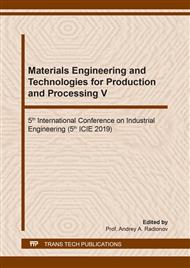p.8
p.14
p.20
p.26
p.32
p.37
p.43
p.49
p.55
Improvement of Strength Parameters of Foam Ceramics for Energy-Efficient Enclosing Structures
Abstract:
Studies of the influence of vibration impact on the strength of foam-ceramic raw material, produced on the basis of chemically modified natural silicites, are presented. The natural oscillation frequencies of mineral particles are established, taking into account their size, density and ultimate shear stress of raw suspensions. It is shown that the coincidence of the natural and forced oscillations of the particles leads to an increase in the thixotropic effect. Using the technology of a controlled «sol-gel» transition in the structure of raw material, swelling under the influence of vibration load, samples of the material were obtained with a higher-quality macrostructure without the use of binders. Indicators of compressive strength and average density of raw and ceramics are given.
Info:
Periodical:
Pages:
32-36
Citation:
Online since:
January 2020
Authors:
Price:
Сopyright:
© 2020 Trans Tech Publications Ltd. All Rights Reserved
Share:
Citation:


